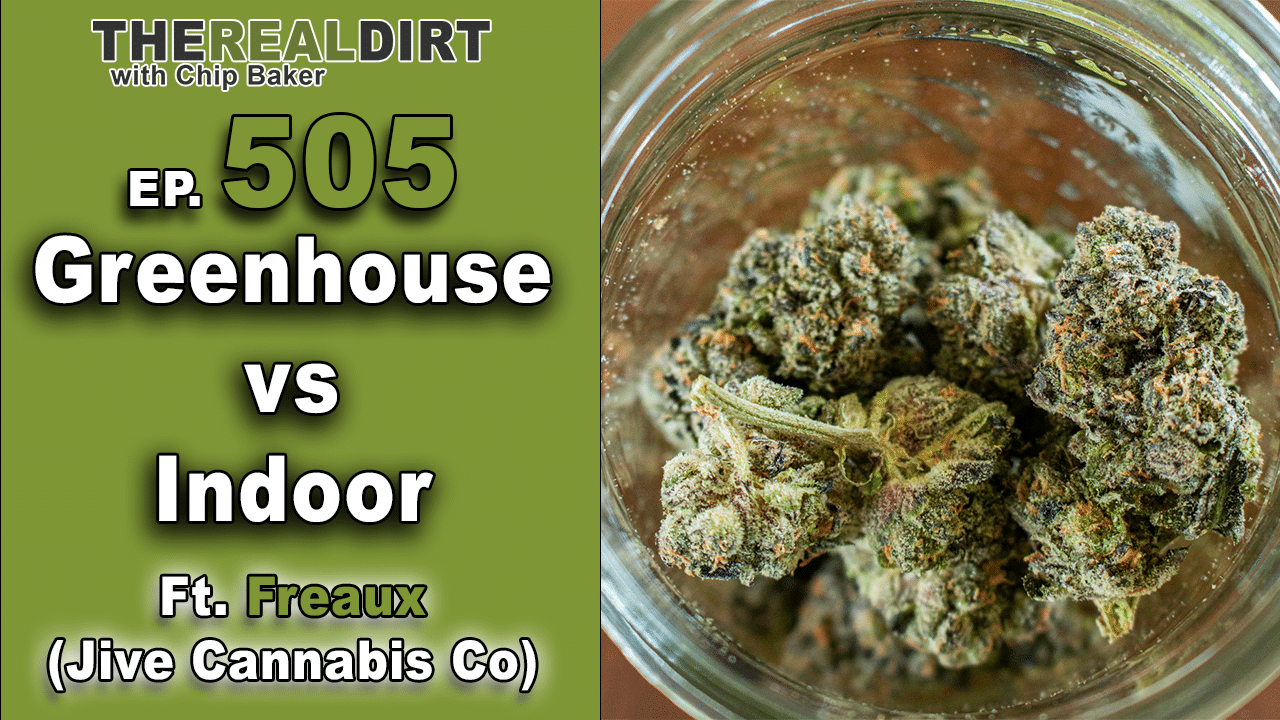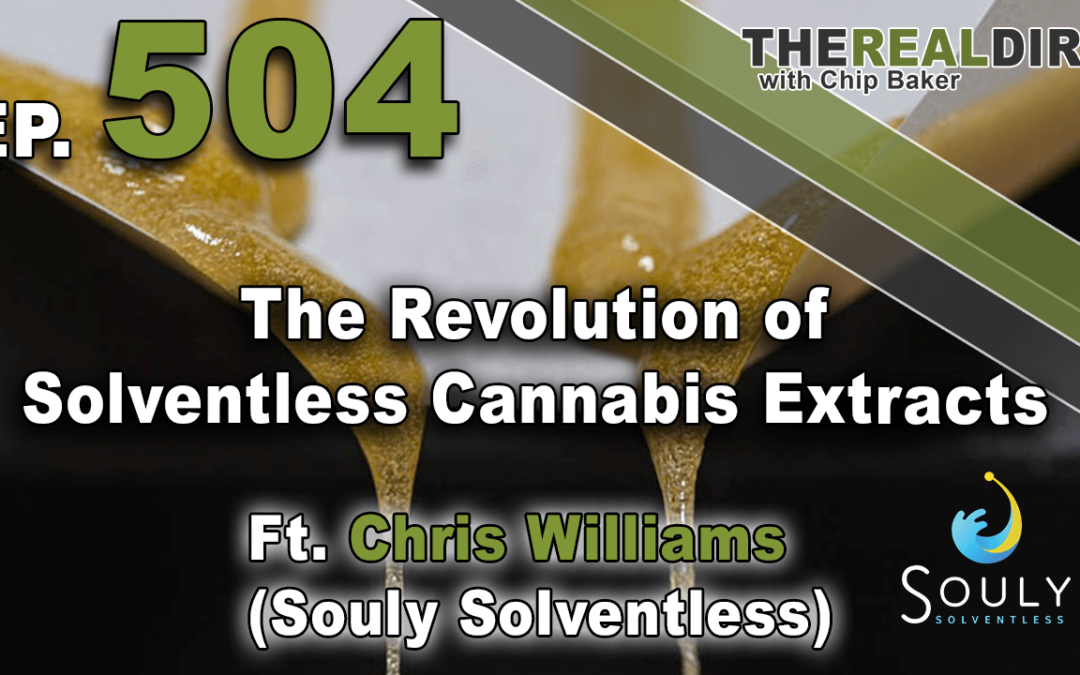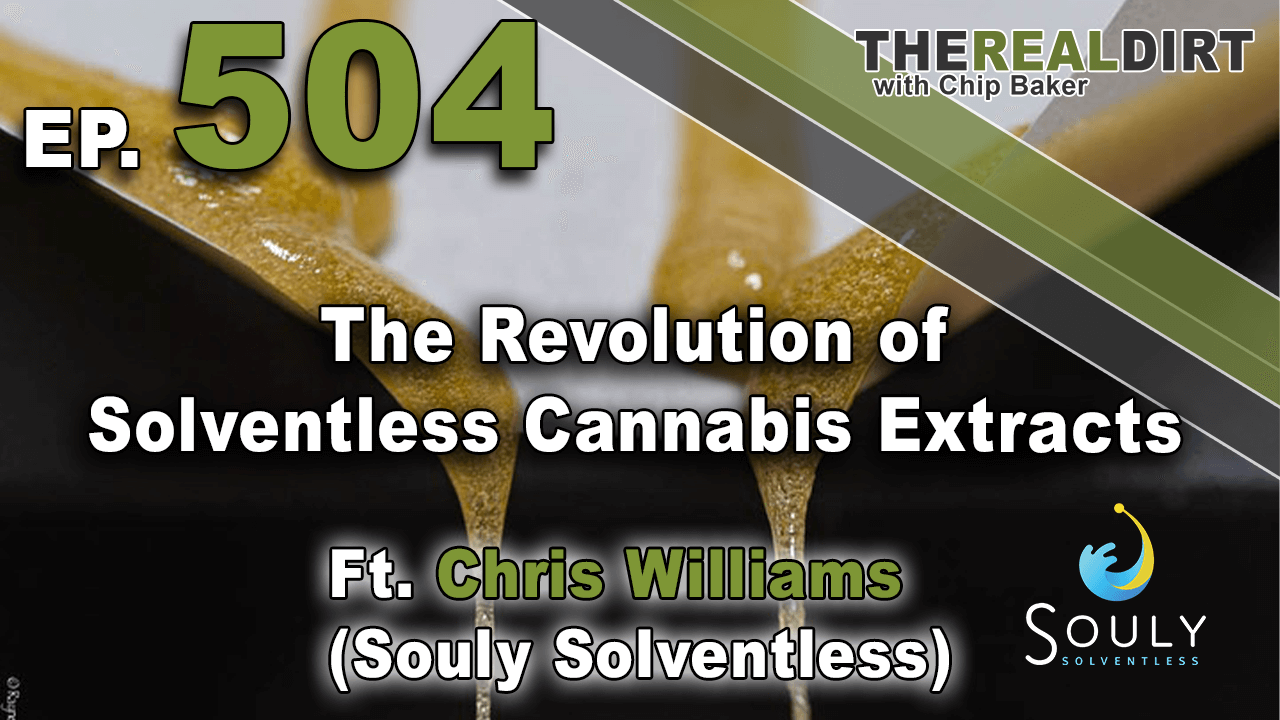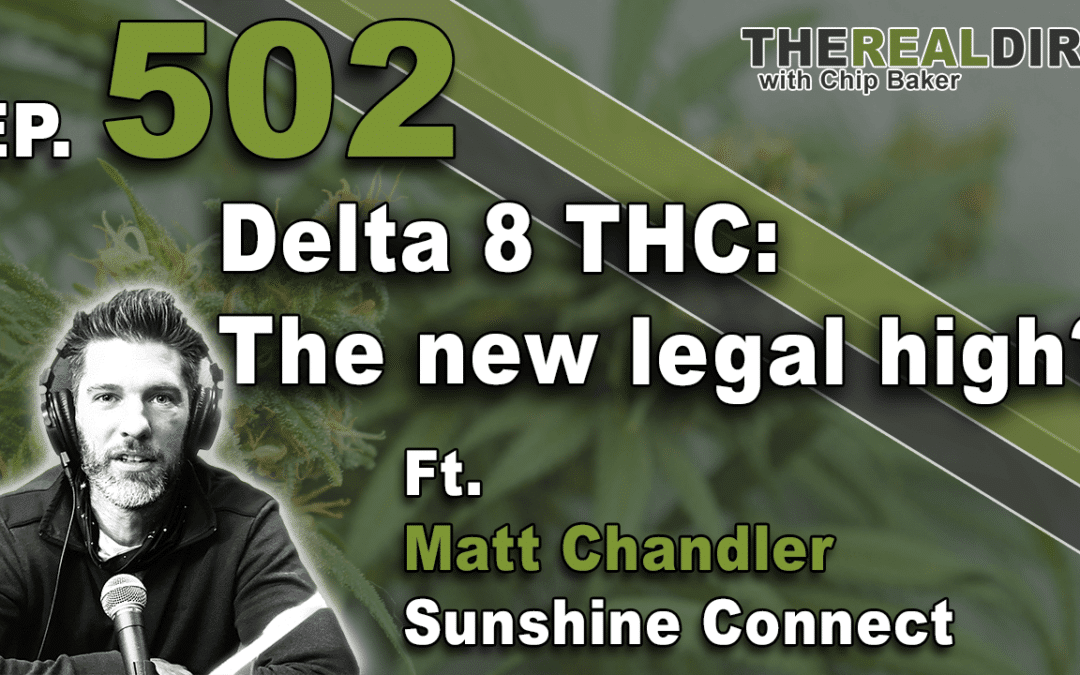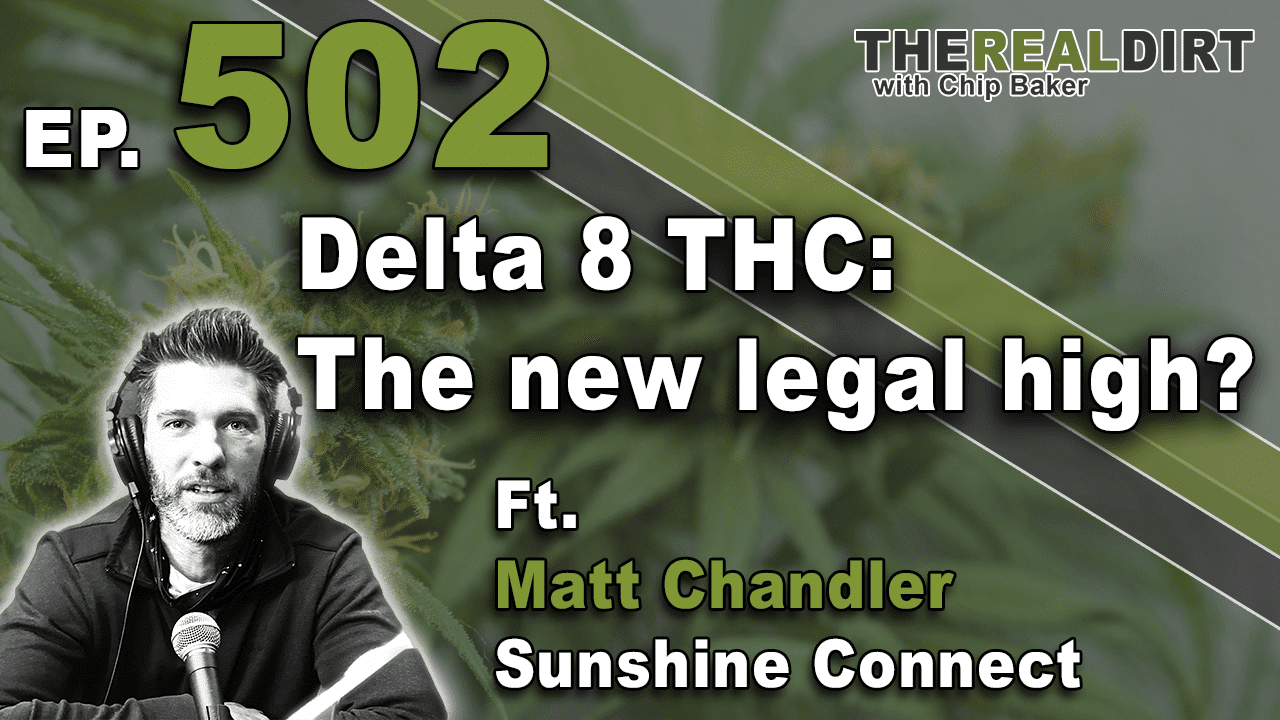![Selective Genetics and Grow Room Designs [Front Row Ag Pt. 3]](https://therealdirt.com/wp-content/uploads/2021/08/Ep509YouTubeThumbnail-1080x675.png)
Selective Genetics and Grow Room Designs [Front Row Ag Pt. 3]
Podcast: Play in new window | Embed
Subscribe: Google Podcasts | Spotify | iHeartRadio | Stitcher | Email | TuneIn | RSS
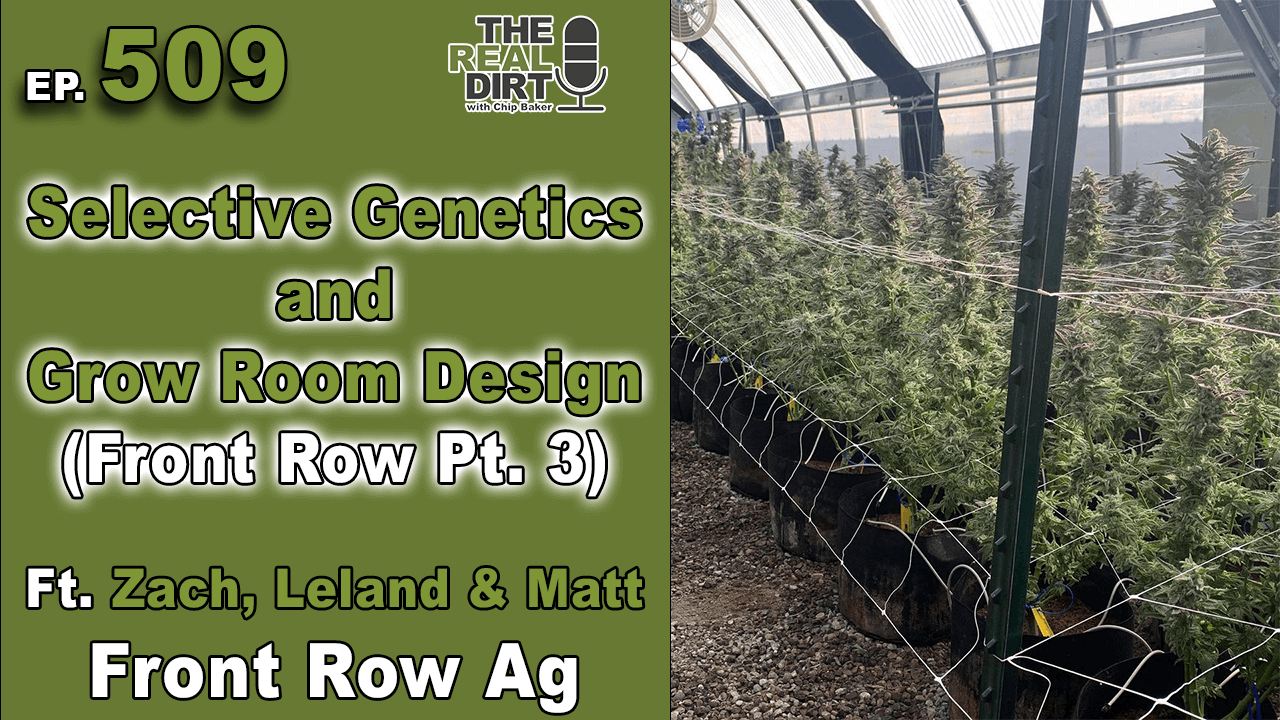
Blue Dream, Green Crack, Gorilla Glue, Wedding Cake.
All of these strains had their time in the spotlight before fading away as more strains gained popularity. And the strains that are popular now will face a similar fate soon enough. Such is the process of cannabis breeding and selective genetics.
Dubbed “The Blue Dream Effect”, it is the process of a strain blowing up on the market to the point where everybody is growing it…until they aren’t. Maybe it is a new, better strain that uses the original as a parent, or an entirely different strain that doesn’t even compare. One way or another, a strain that sits at the top can’t sit there forever.
With demand for incredible, dank new cannabis strains constantly on the rise, it is on cannabis breeders to search for the best genetics to produce. This might be a small grower selecting from 6 seeds, or a large scale commercial operations sorting through thousands of plants just to find a handful of keepers. So how do they choose?
Some growers might just grow what they like and see success. They have an eye and nose for quality cannabis that people want, regardless of the strain. Other growers breed what the market trends indicate as the best to increase their chances of selling all their crop. Neither is the wrong approach.
However the equipment and design of your grow will always impact the quality of your cannabis.
In This Episode
In the final episode of The Real Dirt Podcast featuring Zach, Matt and Leland of Front Row Ag, the guys talk about selective genetics, The Blue Dream Effect and what profiles they all look for when they’re pheno hunting. They also talk about the importance of grow room design from HVAC to lighting, and the new trends that the guys at Front Row are starting to see take hold for the future.
Transcript
Chip: And we’re back. I’m just rolling it up. What do we got here? Some Dosi, Dosidoe 22 from Jive.
Leland: Got some Skittles over her.
Chip: Got some Skittles over here from the Baker’s Ranch. What are you, what are you gonna puff on over there, Leland?
Leland: I’ve got my Truth Serum.
Chip: Truth Serum, Truth Serum.
Leland: It’s pretty good.
Chip: Tell us about Truth Serum.
Leland: So it’s a OG IBL and a Cookie backcross using Gorilla Glue. And it’s a strain that I started working on, working out over at a Dank by Pank in Colorado. Yeah, those guys grow some absolute fire. And this is just kind of a project that I’ve been watching grow for a long time and found this plant. And it’s just one of those ones that you know, really fall in love with pretty easy. And –
Chip: Smells dank, man.
Leland: Yeah, smokes good, smells good. You know, when, when we found it, we smoked through at least 20 different phenos and that one we smoked towards the end and I just remember it hitting harder than anything else. And that’s, that’s really the real way to –
Chip: Laboratory tests only go so far. And we do love our laboratories, we love our purple scientific, we love our terpene results. We spend thousands of fucking dollars on this shit.
Leland: Yeah. You got to look at what like, you can grow everything in the perfect condition and test it to absolutely like, you know, everything you possibly can.
Chip: But if they don’t smoke good –
Leland: Yeah, if it doesn’t don’t smoke good, and grows like shit, then you know. Yeah, like so testing. The ones that really impressed me are guys who haven’t updated their growth since 2008, who are growing, still growing the best weed and nothing has changed. And they just keep it as simple and consistent as they possibly can. And they’re not pursuing the you know, the top end like “Oh, like how hard can you push your plant? How much light can you give it? How much food can you give it? How much water can I give it?” And so we’re just, you know, learning a system and keeping up with it. And they don’t really need a whole lot to make it shine. And so when I see somebody who has everything fully dialed in, and his growing plants all look amazing, it’s definitely impressive. But I don’t think it speaks much to the genetic that it can perform in a perfect environment. I think it’s speaks much more to the genetic one, it smokes amazingly, even when it’s grown in a very like, you know, old way
Chip: Yeah or with, you know, random care. Like, you know, the guy, the guy who grew this weed cares a lot about his weed. This is Freaux from Jive and have him on the podcast all the time, he’s great guy. But we were smoking weed recently, and he brought in like seven or eight flavors. And they were all grown the same because we both have this like, “Hey, I want to plant a bunch of seeds and pheno hunt,” attitude. And we’re literally looking for the best stuff, we’re not really breeding. And, you know, he brings over five or six different strains that were all grown the same. Different strains, flower the same amount of time, given the same fertilizers, and they all looked amazing. But when we went to smoke them, it was a different story, right? Oh man does this Chemdog cross was so much superior to everything else and the white ash that just like fell off of it. And he’s like, “Yeah, fed it the same thing I fed everything else,” right? And it’s literally just like, how that plant digests the nutrients so much more efficiently. So you know, just and all, when we started talking about it, and they all had a unique characteristic that we saw through and contributed to either like, you know, a fertilizer application or environmental application that wasn’t unique to themselves. But man, that is difficult to do, is to grow large amounts of cannabis unique to each individual one.
Matt: Now that’s very difficult, especially at scale. I think what Leland, Leland is saying too is really important and it’s finding a really good cultivar. I mean, when you’re pheno hunting, the only thing I ever wish is I had more seeds of the exact same thing I was looking for. And I was like, wish I just had one more that had this slightly more unique characteristic or was easier to grow like, he mentions a lot of time, because some of the best stuff you find ends up being some of the most difficult stuff to grow as well.
Chip: Yeah, absolutely. I take this approach to it, is as I make calls throughout the grow and as I’ve done this over the years, I’ve been doing this for years, like I’ll see plants that don’t grow the way I want them to, I just throw them away or give them away to other people. Now many people tell me this, “Oh man, that was the best plan I ever had. Oh, I love that genetic. I’ve been still growing it seven years, gave me a plant 10 years ago.” I hear this story all the time. But for me, I’m like, I’m really trying to get through it, and I can’t see it all. But what I want is, I want good growers, right? Specifically for me, I want like stretchers, I want ones that can take abuse and we try to abuse them specifically, right? Because if they can stand abuse, like we said and still grow great, awesome. I do tend towards a certain type of plant structure and nugget structure, but I can see the beauty of it all too. So I’m looking for like, plant growth first. So I’ll make these calls that are just like, and I try to plan it such a number that I can do it, right? And then after we grow the seed out, I don’t even usually take cuttings of first seeds. I just see if I want to. Right, it’s like, “Oh no, that turned out pretty good. Now let’s really plant it, right? And track it and see,” ’cause man, every strain doesn’t deserve it. Every pack of seeds are man, we try to pack by the 200, plant by the 200. So every 10 packs of seeds might not deserve like, a place in the clone room.
Leland: Yeah, it just wasn’t right.
Chip: Well, I didn’t like it, right?
Matt: I’ve been doing a lot of breeding but I’ve done a lot of seed runs where we do like, you just said 200 or 500 at a time. And I don’t know the time over time over time, we don’t keep a single one out of 200.
Leland: Yeah.
Matt: It’s like you said, someone just did, as hard as it is after you spent the real estate. It’s just some of them don’t deserve it though.
Chip: Yeah, they don’t. We’ve lost a fair amount of genetics over well, man. I got these two friends who’ve kept everything. My buddy Collin and my buddy Fletch, like for 20 years they’ve kept every –
Matt: I’ve got like, 5000 square foot grow with 93 varieties in it.
Zach: Well, well actually, like –
Leland: Fletch is responsible, I’ve heard that name plenty of times.
Chip: Yeah, yeah.
Leland: He’s responsible for getting the OG out to everyone in Colorado.
Chip: Oh dude. Fletch has made it happen for so many people. But you know, they’ve been able to retain it and I was talking to him the other day. And he says he has all the strains that we’ve been smoking and talking about for 20 years. And, but he just used this catalogued. It’s not something that they often flower or you know, they randomly do but point being is no, mostly I planted out thousands of seeds and there’s not terribly many I kept. Right now, actually we have a, we have a Trainwreck backcross from Trainwreck seeds we made 10 years ago that’s in the stable. We have a Cookies and Cream that we picked out of like, a 10 pack search. We have a Granddaddy Dawg that we picked out of the same way. Everything else came either we made, or came to us via like a clone or a cell culture, right? Plant, we planted out thousands and thousands of seeds. Yeah, right.
Leland: A thousand is the magic number to find something really special. And I know that just from the experience of you know, having popped 1000 ones but just going through them you know, 100, 200 at a time like every –
Chip: ‘Cause you can something happen like that, right? Like, hey, I plant a hundred, plant a hundred –
Leland: You’ll find some decent stuff in the 10th pop. You’re gonna find one the 10th time you do that, you’re gonna find a plant that’s like, “Oh, Jesus.”
Matt: That was the one.
Leland: That was the one. I have a buddy like you know every now and then it’s like a lotto. Like, I gave a friend of mine five seeds that he popped and then we found like an all strain, and there was like took five seeds that time it’s –
Matt: Tuesday out of our commercial varieties and this goes to what Leland is saying is, probably over half if not a super majority of them are still really high-end varieties we paid for from people that sprouted 1000, 2000, 3000 seeds to find one winner.
Chip: Or got lucky, man. You know that Purple Trainwreck that’s throughout Colorado. We planted out hundreds and hundreds for years of that same genetic, and didn’t find a keeper. A friend of ours in San Francisco planted out 10 seeds and found the keeper, right? And then we stopped planting out seeds and then that’s the Purple Trainwreck this in Colorado. Because we liked the weed but like, we just didn’t find the keeper and he just lucked that y’all did. So it can happen. You can plant one seed and get above and lucky, right? And we see that with all the great, with lots of the great strains out there.
Leland: We did a Pandora’s Box backcross. We just had some seeds and we had a whole room that was only Pandora. And then whether it’s a light leak are something happens you know, you have some hermies here and there .And then we kept the, I mean it’s probably out of a 2000 square foot room, 100 seats or so total. And found a really, really nice one out of just only sprouting about 20 of them.
Chip: You know, we get, we got this great job. And I kind of touched on this earlier is we get to see these grows all over the country and world, even, right? People invite us from places all over to come to their grow, their product support or just to like, show off or you know, just to smoke us out. And man, what are some of the like, the strains or strain trends you guys are seeing out there?
Leland: Probably the most common stuff that’s being grown are all of the you know, Cake and Pie and Dessert plants, which I personally like, I see the reasoning behind is because it looks beautiful.
Chip: They’re good growers.
Leland: Huge potency, great yields, easy to grow.
Chip: It’s the Blue Dream effect.
Leland: Yes the Blue Dream effect except like, at least Blue Dream like had like a nice creamy positive vibe. Like, I’ve just haven’t been able to enjoy a stone off of any of those plants.
Matt: Well, hopefully for you it will be, it’ll be a phase just like you know, the Gorilla Glue days and the –
Leland: It reminds me a lot of the Gorilla Glue days.
Chip: Lava cake’s pretty good. No I’m , love to see the Wedding Cake grow, right? We’ve got plenty of cake crosses.
Leland: Blast to grow. And like I said, I see why everybody likes to do it.
Chip: Yeah, it’s pretty good.
Leland: But uhm yeah, it’s I guess –
Chip: The customers like it too. Pretty in the garden means pretty in the dispensary, and you know, ate the weed. Customers like it too.
Chip: Hey, this Dosidoe 22 is a perfect example. Like it doesn’t quite have the same look as maybe, you know, what do we got over here? The Hot Rod or the Cookies and cCeam? You know, it’s thinner calyx, it’s white, almost.
Leland: Yeah. And for me, like I guess my, I’m a more, I’m more of a, I like the smells. So for me, I’ll pass on the looks if it smells amazing. And I follow my nose. I mean, we’re –
Chip: Yep.
Matt: I mean, when I do shop at a dispensary. It’s, I walk in and they’re like, “Well, do you want the most potent thing? ” I’m like, “No, I want, I want what’s going to be the most flavorful and smells good.”
Chip: What tastes the best?
Matt: Emphasis on flavor.
Leland: That is nice.
Chip: Yeah, yeah, it is. But you know, it’s different, right? And we can appreciate it, you know. And many people buy it just because it’s Dosidoe 22 or whatnot, but it doesn’t quite look like what the, what the average Joe weed smoker considers good looking weed. It doesn’t look like that.
Leland: No, that’s a, that’s fair. I mean, it’s like why do we say it’s a trend? I mean, people really like purple. They like frosty. So when you can get purple and frosty and hit over 25% THC, it’dbe like hitting the 30s mid-30s then yeah, people are gonna eat that up.
Chip: So man, what do you think about like, what do you guys think about this like, this naming thing that’s happening right now with, with you know people just using like, candy bar names or, or, or, or candy names? And I mean the cakes and the pastry that type of thing comes in there too. But like, man something that I’ve always like, how does the, how does the rubber meet the road on it, right? Because like a great name doesn’t make a great strain, right? But man, call something Sugar Babies and it’s great. And you’re like, “Goddamn pass that Sugar Babies, you know?”
Matt: I don’t know. Back in the day, all they do is add “diesel” to it and it would sell twice as much.
Leland: Yeah.
Zach: I don’t know. I don’t know. I missed that whole train. So I feel, I feel kind of like an old man looking at it confused.
Chip: What happened?
Zach: Yeah, I know, like, you know, if people are doing that, they’re probably older than me. But it’s just like, it’s, it’s questionable for sure. I think it gives the industry a bad name overall, because like it gives the feds something to come after us over. It’s like, “Oh, well this is obviously marketed towards a child.” And it’s like, in a way it is, but uh you know.
Chip: Weed definitely makes me feel childlike all the time. It’s something that I’m gonna constantly got to hold on to, but it’s not for children.
Leland: Right yeah, it’s easy to take these contacts and distort them if you’re not stoned and having positive memories of going to the fridge at 2 AM to eat ice cream. And like yeah.
Matt: Yeah but too, I mean, even if you’re breeding say poinsettias for instance, it’s up to the person that genuinely creates the that F1 to name it what they so choose. And whether it’s based on the genetic lineage or just some random, random thought or happening, that’s it is up to them. But much like Leland: said, I think too, there’s a, there should be some regard but out there for how you choose the name and respect and common sense maybe.
Chip: Well, I’ve always preferred like, some type of genetic tree hint in the name. As opposed to calling something cornflakes or Sugar Babies or something like that, right? Like you know at least like, the cake stuff, you know, we’d be like, “Oh, it’s Dosi cake,” you know? Or you know, you hear like, you know what it is, you know? ut then I mean you got stuff like Race Fuel and Hot Rod and Rude Boy and All Gray OG crosses that have no like, name like, hint to their lineage but are great names.
Matt: We have no idea what they are. Unless you, unless you really know you look into it. You remember, you know, you figure it out.
Chip: Right? And you trust Leafly or whatever to tell you the correct information. ‘Cause often is, it’s not really correct.
Leland: Loogle.
Chip: Yeah, yeah. Right, right.
Leland: It’s like Wikipedia, you can kind of say whatever you want.
Chip: Man, we go in these rooms all the time. What about growth trends, man? I mean, you know, a big trend that’s been trending hard for a number of years is LEDs. And now it’s like, double and triple stacked flower and veg of LEDS. And like, man, you know, let’s, let’s talk about that for a second. The rubber meets the road.
Chip: We still help, we still help consulting on building quite a few grows out. And a lot of the time, I guess, the triple racking is extensive versus intensive, this conversation we have a lot of time. And then budget or and building too. So if you know, I guess where I would start, if I had a really small building, and my space was going to be limited, and I knew I could never expand, I might look at, you know, some multitier systems and you know, you know, like a pip racking system or something like that. But if you can build out a large amount of area and/or expand over time, the ergonomics in a single tier and a single plane, you’re going to grow better product at a cheaper price, because you can get to it, it’s more accessible. But I would say that those are definitely trends. And we still help people execute both of them. And there’s issues you have, you encounter with them both. I think LEDs for the first time in the last for the probably last two years, definitely, and maybe three years have been a suitable replacement for double ended lights.
Leland: If you, if you’re growing at a large enough scale, you can anticipate the ROI on them. Because it is still like, you know, three to five years of the firm pricing, but –
Chip: You gotta want to do it.
Leland: It’s worth it. Yeah, that’s your your, yeah, if you’re getting LEDs you’re planting like, you know, you’re gonna be running that spot for 15 years. It’s pretty much like, what like otherwise, if you, if you’re planning on popping it up and shutting it down, then maybe LEDs offer some versatility in terms of like, portability. Yeah, you’re better off throwing 1000 watts and getting that shelf life out on them, becaus an LED is built for 10 years, and they’ll hold that efficiency will hold up those standards aren’t going to change much past what we’ve already got.
Leland: No, yeah, you’re right. I mean, you know, we talked to this about people all the time is like, you know, periods of growroom construction. And you’ve got like the 90s, like pre-2009, the, you know, for, you know, 2014 we call it and then like, you know, modern stuff. Yeah. And the interesting thing is, if people do a couple of things right, then they’ve been able to like roll through all of this, right? And the one thing that people do if they do right is their environmental control, right? They do their environmental control, if they have a lighting plan that lights the room and associated with the lights they’re using and not just thoughts they have on how to put lights up, right? Then that’ll last a decade, right? There’s you know, and everything underneath those lights can change over that course a decade, because it will.
Matt: The most important thing is mechanical system. Like you said, the HBSC, the heating, the cooling and dehumidification. One good point you brought up though generate, the the different generations or decades of growing. And I think it’s been lost over time. Because the people that originally built and designed the grows ran the grows And had to be responsible for the product produced on them.
Chip: Yeah.
Matt: And then today, you have tons of people that build and design facilities that have never operated them and never gonna show up after it’s done.
Chip: And growers that have never built a system. And they’re like chefs, they’re like, “Give me the kitchen and I’ll cook in it. But I don’t know how to put in a vent hood. ” Right? They’re not restaurateurs, who were like, “Oh, here, I’ll put that vent hood in myself, you know? After hours, so I wouldn’t have to deal with the permit, you know?
Matt: Yeah, yeah. So I mean, the LED though, I think in multi-rack system is is a great choice. And then with some of your higher discharge LEDs, it’s a great choice for even your rolltop benches and your higher bay lighting situations. Where most people go wrong., and what we see still is just, they might install a really good control system, but they don’t quite understand the mechanical system or how to, you know, run the environment that they want to or need to.
Chip: Man, contractors all over the world are putting their two cents in, which is great, that’s what’s getting Colorado where it’s at. But like a lot of them are kind of wrong. You know, they don’t have experience in it or they won’t call up the manufacturer and you know, it’s really –
Matt: It’s weird dealing, having an argument with an engineer about why as logic his wrong, it’s very bizarre.
Chip: Hey, guys, just quick break to tell you about Cultivate OKC, Cultivate Colorado. You know, I got into the hydroponic supply business 2009. I had wanted to open up a retail hydroponic store for years and I was already making potting soil at that point, maybe some fertilizers and some other stuff I was into. Yyou know, I hadn’t opened up a retail shop and I got this opportunity to open one up and California. Right as I was fixing open up down in Riverside, Colorado came along, ended up being better, bigger opportunity, opened up our Colorado stores. And you know, man, it’s just we’ve been off to the races ever since. Now we’re in Colorado and in Oklahoma. We ship all over the country and even the world, man. It’s amazing the people that call us contact us that needs, that need some equipment to grow their fine cannabis with. So if you need any help, any equipment, if you want to come to a great grow store where people don’t judge you, we’re not clique-oriented. We’re just there to help you grow. Man, come see us at cultivate. Cultivate Colorado. We’re on exit 206 i-25. We’re also on the Stapleton Monaco exit there on I-70. And down in Oklahoma City, our newest store and man probably like nicest showroom right now is we’re right on the corner of 10th in Meridian. So come check us out 1101 North Meridian. Yeah, man. Got any questions about growing no Matter if you’re big or small, just come on in. We’ll be glad to chat with you. Okay, okay. Well if you, if you’ve been listening to the podcast for a while then you know that I like potting soil, make potting soil coco potting soil, specifically. And you know, I just wanted to talk to you about how much I love coco fiber and why you should use it and why your plants should be in coco fiber and they’re gonna love it too. One man, my new product Coco’s Growers HP is just an incredibly clean product and made for indoor cultivation. I mean you can use it anywhere but man, it is clean as you can get it. We try extremely hard to avoid all cross contamination. All bugs, weeds in seeds, we keep it all inside his manufacturer, all inside. We treat it like a bakery, we start out clean, we end clean, we clean up while we’re going through the day. We really try to try to take a great effort to put this quality product together. So the number one reason you should use Growers HP is man is clean. Number two reason you should use Growers HP is man, this product we have developed it man, almost specifically because we want to see like, just incredible root development and root growth, and that’s what this product does. You know, I used to be a diehard coco only guy, compost coco and I just saw the benefits of peat and so we started putting small amounts of peat in it. Man, the roots take off. Coco and peat just blend together so well. So there’s, there’s the second reason that you should buy Growers HP is man, just to increase root development. Now, the third reason you should buy Coco HP is because man, it’s a really a light potting soil. And when I mean light, I mean that like, you can most people can pick up four bags at once kind of no problem. It’s light like this, because of the way we make it, the way we can control how much water we put in it, we make it a really dry elevation in a really dry high elevation area in Colorado, so it dries out really nicely. And when it gets in the bag, man it’s as light it’s lighter than any potting soil of two cubic foot that you can get. So there’s the third reason man, is it’s a really light product that the moisture is controlled in it specifically. Now, the fourth reason is man, it’s real easy one, man. It’s just because your friend Chip asked you to go support him, support The Real Dirt and buy some Growers HP. So there you have it, man. Top four reasons why you should use Growers HP in your garden.
Chip: There’s an HVAC conversation we have all the time with people, and you know that’s why at you know Greener Consulting Group, we have our own HVAC engineer. You’ll get an HVAC guy who’s like, ” Oh okay, I can design this and put it in.” And he might be a really good person to install equipment, but maybe not the best person to design your room. And if you get that which is most, honestly is most of the craftsmen in the world, right? They know how to do this one thing or two things. They don’t know how to do both sides of it. They can build a house, they can’t design it, right? But man sometimes they do design the house, and there’s something that’s just not right with it. And the same thing with HVAC guys. And that’s why it’s really important on your HVAC to like get it like, designed by a professional, the equipment supplied by the professional and get somebody else to install it if you can. Or just tell the HVAC guy, “Hey, this is what I want, and I don’t want your math.”
Matt: The wonderful part about you having a professional in-house is that and it’s crazy to me is from project to project to project and having built 60 or 70 of them, though, is almost every time, it’s a brand new engineer,. And like you just said, they’re starting for over, they’ve never designed one of these spaces, and they can absolutely get the words right. And maybe, but it’s not, it’s not going to be a product that someone’s learned from generation to generation of different growing styles and equipment.
Chip: Yeah, absolutely. And, you know, we, we do all of our stuff in-house here and as much as we can. But you’re right. On every single job, there’s a different contractor and a different plumber, and a different electrician that you have to talk to. And, you know, many of these operations don’t have to have like blue, blueprint, you know, quality electrical background. They end up being as good as the electrician is. The HVAC is, right?
Matt: The over regulation out there allows electricians and other contractors to really, you know, put full investment so to speak into the work, like –
Chip: Colorado, they have like a history of it now, right? So you can call somebody up, he’s like, “Oh, man, I’ve never done that before. But this guy has, or my buddy has,” and he’ll tell me how to program or how you know. And so you get like, Colorado’s a premium place for it to happen. That you can call up any random HVAC guy, and 50/50 it’ll work out pretty good for you. The rest of the country is not as easy.
Matt: Yeah, they have 10 years of experience now, though. And they’ve forced each other to be super competitive.
Chip: Yeah, absolutely. Absolutely.
Matt: Which is a good thing.
Chip: Yeah, yeah. Yeah, man.
Matt: I mean, in Arizona, we’re where I live, it’s a huge struggle versus somewhere like Denver to find quality craftsmen. For specifically the cannabis industry. I mean, if you want to build a custom house, or you want to you like you said –
Leland: There’s specific contractors out there definitely.
Chip: Yeah. I mean, there that’s why I started the Greener Consulting Group is because I had contacts and all these, you know, different groups of people, right? This huge network of people that could do it right. So I can just call up the engineer who I know has done it before, electrical engineer for plumbing or whatever irrigation guy and like, get him on the job. It’s a better scenario for us. But I tell you man, if you’re out there thinking about building the operation, just call somebody like me. You don’t have to call me. But like, you know, greenerconsultinggroup.com is a great place to start but call somebody who really knows what they’re doing. And don’t ask your brother in law, who may be a really cool guy – and I got a great brother in law, Scott Outlaw, yeah. But you know what I’m saying, you know, get like someone who’s had a history in building like, many of these things. And there are many, many people out there that have seen dozens, built dozens built hundreds. I mean, Cultivate Colorado, I don’t know how many grow rooms we’re helping people build right now.
Leland: Thousands and thousands and thousands.
Chip: Yeah, man, I mean, 100%. And I mean, you guys have seen the same thing too. And we’ve all seen people scale from small to like, large. And you know, it’s really important to call people that absolutely have your interest in heart and don’t just want to like, sell you some stuff. And that’s everybody in this room, you know?
Matt: I think a couple of the trends I’ve seen too, while we’re on the topic, is you brought it up where control systems. People going from using almost you know, thermostats on the wall, to you know, some really really simplistic controllers to now, a lot of people are investing quite a bit money in control systems. And then also dosing systems whether it’s the ones that, pretty sophisticated ones in medium to large scale grows.
Chip: Yeah, absolutely man. I’ve just, I’ve used dositrons for years. I bought my first one at a police auction, nobody knew what it was. I got it for like, 10 bucks.
Matt: That’s killer.
Chip: And I had worked with one when I was a kid.
Matt: That was my first experience was as a kid using the old, the old D-12.
Chip: Yeah, this was probably a D-12 even. I grew tons of weed with that thing, those things are bulletproof man. And I hadn’t, and I’d kind of gotten away from it for a long time. But now we’re here in Oklahoma such huge scale, you have to, right?
Matt: Absolutely. I mean, it seems whether any of those types of systems, especially the like, Dositron type system, the labor savings on a daily basis from non mixing out and weighing it, looking at it, it’s you know, precision injection, and it’s gonna be pretty accurate every single time.
Chip: Right yeah, absolutely., man.
Matt: Hours.
Chip: Yeah, absolutely. And you know, there’s some limitations to the dosers. But like, there’s just tons of applications, people use them for years. I actually we started using again a couple years ago for our pest control methods, right? And we mixed up a stock solution, I’ve got like a portable cart with my doser on it, my sprayer on it. And you know, the whole unit just goes down to whatever section of the garden I got 100 foot hose, we spray everything down the way we want and then just move it to the next section. But we put quick connects on it all and so it just, you know, pops in and out of place and really easy to make. We strapped it all in on a dolly, you know?
Matt: We started using them for even cleaning products.
Chip: Oh, yeah, absolutely.
Matt: Who knows how wasteful people are just even measuring out, you know, $3 gallon bleach. Or, you know, 30 to 50 dollar gallon of biosafe products, which are wonderful. But you start to see the mismeasurement of them. And the savings, and the return on that, it’s I mean, it’s quick.
Chip: Yeah, absolutely. So we’re on, we’re on trends. Man out, you guys got outdoor indoor, like, mmm, it’s always a big conversation with this,. Like, you know, how big the outdoor market, you know? How bad is it?
Matt: We’re having this cool fusion now, like, the coolest trend, I think I’ve seen has been the new greenhouses that are getting built, the high wall hardtop. They’re really making a good case for efficiency, in terms of just like, yield per square foot amount of turnover. And the amount of power it takes to run it and keep it stable through all four seasons. So you know, it’s a pretty high investment, when you’re looking at basically spending as much money building a greenhouse as you are building an indoor facility potentially more. Like in the upwards of like, 3 to 350 a square foot, but you’re building a building that’s going to grow weed anywhere in the world, or grow any crop anywhere in the world, and be able to create any environment that you want around, it’s pretty phenomenal. So yeah, I’ve seen these systems running in like, places where they’re dealing with a 20 degree winter, sometimes dipping into the negatives, and then having to combat 100 degrees summer. Everything stays stable, they don’t skip a beat on their production, it’s pretty incredible to see.
Chip: Yeah, you know, the use of thermodynamics is, you know, as a, as a natural source that we all have is incredible. And these greenhouses really like, show it. And we use it in our business all the time for you know, just moving air around, right? And we see it in grows all the time. But um, you know, these high wall greenhouses, you’re able to really separate the heat from your greenhouse, you can, you know, there’s many ways people do it. But like, you know, passive roofs or roofs that are open or roofs that vent, or, you know, circulating air from the roof down into the inside of, you know, when it’s cold like, I mean, it’s, it’s really exciting on what’s going on in greenhouse efficiency develop. And, and man, like, all the types of like, natural heating and cooling technologies that are going on right now. Water glycol, like, you know, radiant floor, and geothermal, like, there’s just so many great options.
Matt: Yeah, it’s, it’s pretty cool. It’s been wonderful. I mean, the one thing the cannabis space is afforded from a price per pound that we get is investing in some of the best technologies that are available. So it’s great, you get to see all that stuff.
Chip: Yeah, they get to afford too and, you know, man, I take cannabis growers, man, you guys like, I just love how excited you get about the next thing, because I get excited. Right?
Matt: One thing, I gotta say that I’m total nerd for, like, you know, waste potential. And just know the stuff we throw away that we view as trash. And like, the ways, the things that we’re going to figure out to, you know, incinerate and re-capture and concentrate that and turn it into something that’s usable. Whether it’s more plastic, whether it’s compost, you know, there’s, there’s a lot of potential on the horizon to clean up our mess and make an industry out of it. And those are the cool things that I see. So you know, I choose to have potential for the future and the outcomes, and the science that’s being applied to the situations that we’re in that we contribute to every single day, because in my opinion, like there’s never anything short of potential in every situation, so.
Chip: Yeah, it’s important for us to be stewards of the land, of the world, of our community, of each other and that means you know, like really thinking about your impact and and you know, how you can benefit the most from it and eliminate, limit it the most, you know? It’s this constant, constant battle, but it’s something all business should think about. Blowing off, you know, environmental concerns, man, you might be able to save like, you know, 20 or 30% on your waste removal if you contact your you know, manufacturers or vendors alone, and say, “Hey, don’t send the plastic. Don’t send the cardboard. Don’t wrap it to me.” I mean, there’s all kinds of like conversations you can have with people and many vendors, they’ll still, “Oh, yeah, sure. You know, I won’t put a pallet topper on it for you, you know, I’ll only wrap it twice for you.” And that’s like better for you, because you’re putting 20% less into waste disposal. And, you know, that’s just one thing way to think about, you know, our environmentalism, and how there’s a return on investment and the smart business people, they try to hustle that all the time.
Matt: And even, yeah. I mean, even at Front Row, I mean, using a dry soluble fertilizer, that you’re not buying excessive amounts of liquid bottles and putting that burden on the environment. I mean, people will look at it differently., but when you use something that goes the furthest and has the highest usage, you’re –
Chip: Give me a stat on that. How many one bag of Front Row, which is uh, 25 pound bags?25pound bag, and it’s like, I don’t know, it’s 20 inches, 24 inches by like 16 inches, that’s how big the bag is, right?
Matt: 17 gallons, depending on the part.
Chip: So that’s 12 to 17 gallons. So that would mean you know, you know, you would have 71 one gallon containers. Okay, your –
Matt: Your 25 pound bag.
Chip: Yeah, you know, 125 pound bag. Oh, use five gallon containers. Whoa, man, you’d still have four? You know, if you have 17 gallons, ’cause like your two and a half gallons gotta come from somewhere.
Matt: And the density of those materials from injection molded bottles, whatever it is. That’s what’s crazy.
Chip: Yeah, exactly. So you know, that we should all think about it, man, that’s for sure. No Matter what it is in our business, right? Hey, man, we’re already kind of into the future, dude. Let’s, let me, let me hear some predictions. What’s, what’s going on next? What’s happening next in cannabis?
Leland: Oh, boy. That’s a lot.
Matt: Yeah, that’s a lot.
Chip: Just pick, just pick one.
Leland: Um, I would I would like to think, you know, we’re talking about the greenhouses. There would be some more efficiency from that standpoint. Hopefully some more investment into stewardship. You know, as we run into problems, we’ve always been problem solvers. We like to throw ourselves at problems and make things better. And I think that’s one of the coolest things like, going back to one of our first conversations we had about the liquid nutrients and like making it fun. Like, how else do we keep making this fun? And so I think being able to, like, you know, think beyond just the grow and like how we’re taking care of ourselves in the backend, I think that’s a trend that’s developing. And as a community forms and network forms, and we get consumers and we get direct consumer feedback. And now we hear from people and dollars are speaking on a legal, on a legal basis every day. So I think that’s one trend that’s developed pretty quickly. And then, yeah, another one would probably just be the weeds getting danker.
Matt: Weed’s getting danker. [inaudible 37: 59] watch out , yep.
Chip: [inaudible 38:05]. 50 percenters. You guys remember Cheech and Chong? One of the things that they made this joke is like it was a grow joke. It was like , ” I want the Afghan that don’t stink,” rtight? You know, the joke there is you don’t want anybody to smell it , ecause you’re growing it or you’re like, transporting across the country or in the airport. You don’t want to get caught. But like now, it’s a different story, right? Yo, Afghan gotta stank.
Matt: It’s got a stank, yeah. I think on the flipside, from, you know, the future and what I’ve been seeing it definitely from a trend is especially, in limited license states where you’re say, you’re like in Maryland, or Arizona or states that don’t just have you know, like, 900 growers like Colorado, for instance. The most successful operators in those states have started consolidating some of the businesses in those states and then also going out and becoming more and more often, what we refer to as multi-state operators as well. So just from a general trend, and what’s you know, continues to happen in the future. I found that interesting as well.
Chip: Yeah, no you right MSOs are that’s a new buzzword 2021, right? That’s for sure is gonna continue, man. We got some new markets coming too. I’m excited about that. And, you know, we’ve, we have, we’ve been a part of the green rush, you know for my whole life really. And, you know, late 90s, we ran to California when they legalized it over there and it’s like popped all around California, and Colorado, and now Oklahoma. And been into so many different states and like –
Matt: The southern states coming up too.
Chip: Hey, that’s the interesting thing to see is now it’s going to all you know, like different climates, different people, different applications. A lot of the southern states is just like, “Oh, it’s gonna be 5% THC.” So that’s gonna be different, like, you know, requirements of like cultivation, different requirements of extraction, different products. Then like what’s happening in Colorado, you know, which is like this awesome high quality, you know, product coming to the marketplace, cream rising to the top. And that excites me to see ’cause that’s really of the market developing, because it’s not just one way. There’s so many different ways to like, work with this plant.
Leland: Yeah, definitely. That’s a big part of the potential in it that’s untapped is the, our markets are still developing on the smokeable flower side, but we haven’t even like, we’re still ground floor. It’s doubling in size the market once all the states are legal. So it’s, there’s that extend for as well as the industrial applications. You know, the potential for this crop to really change the way that we farm is pretty incredible. It’s it’s awesome.
Leland: And I think one thing for the future that we didn’t, we don’t really touch on as well. And I found important and maybe in the stewardship, stewardship side of it is the footprint of the industry, the focus on greenhouse and outdoor and states that are really well equipped for that. And being able to grow at a more expensive level. And those I think that’s going to be good for the future. You know, some of the southwestern states where it’s dry and temporary, during certain parts of the year are going to be great for growing outdoor and in greenhouse climates.
Chip: Yeah, absolutely, man.
Leland: And then you won’t have to have these mega facilities that have you know, powered and man’s multiple times more than data centers, and then hundreds and hundreds and hundreds of them.
Chip: Yeah, absolutely, man. It’s, you know, weed has grown all over the planet in so many different ways. But the commercial aspect of smokable flower has been concentrated in kind of the northern latitudes in northern Western latitudes, specifically in the US. But like Canada, Washington, Oregon, California, you know, those have been major, major major producers for years and years and years. And now like, there’s all these local regional producers, they all are following trends and making their own all at the same time, man, right? Damn, guys, man, this has been such an awesome Real Dirt episode. We’ve been trying me and Leland: have been trying to put this together for two years. I haven’t made enough time for it. And then there was this weird international like, thing happened. Right, you know, I wish we could have just like, you know, just, you know, you know, it’s almost like getting held back a year, right?
Zach: Well, [inaudible 42:37]. No way.
Chip: Yeah. Well, you know what happens when you get held back a year? Then you’re bigger than everybody else in your class. No, it is positivity. It’s been in the cannabis industry, like it’s proven great in so many different ways. You know, but unemployed people smoke more weed. Hmm, stressed out people like to smoke more weed. There’s more legal weed, more different environments. It’s given people a chance to prove it and use it. There’s like, drug testing that hasn’t gone on and you know, as we were like, “Oh, man, well, I’m not going back to work for six months.” I might as well puffy puff puff.
Zach: I’m working from home, yup.
Chip: And you know, in Colorado like, consumption didn’t drop at all but tourism almost stopped. All the locals are like puff, puff, puff. 50% of the business came from tourism.
Zach: Crazy.
Chip: Right? And so everybody just [inaudible 43:39].
Leland: Yeah, I remember that. Every state were involved in cultivating. We’ve seen usage during during COVID go up?
Chip: Yeah, yeah, absolutely. And, and our industry is going to continue to grow and rise and hey, man, if you guys got any questions, I want you to reach out to Front Row on their Instagram site, on their website, their phone number, which is what’s the phone number?
Matt: Put me on the spot again.
Chip: I know right? Yeah, let’s call Leland: –
Matt: You can get us on, uh, on the website, under the customer service section is just a form to fill out. Fill out that form real quick. And, you know, either me or one of the other guys on the team will get with you ASAP. We’re really, really good about responding that way. That goes straight to our emails we get notifications and, you know, everybody’s everybody loves doing it through email. That way, we can just keep the conversation kind of recorded and go back, because it gets overwhelming if you’re going to call us. And just keep calling then especially through the 1-800 number then we really have no recollection or record of the conversation.
Zach: Go to www.frontrowag.com. and fill out the form. That’s the way.
Chip: Right.
Zach: And so I’ll tell him tell him that you are listening to podcasts and I will hook you up for sure.
Chip: Yeah, tell him Chip sent you .So, “Hey man. I listen to Chip’s podcasts all the time.”
Chip: I can hear his voice in the back [inaudible 45:17]. No people say that to me all the time, man. And that’s really what the purpose of this is, is I want people to have better experience, to do better. I’m interested in what people like you guys are doing in the industry. And I truly want to like, convey actual knowledge to the people that want to get into the cannabis industry or are already here. Right? Because you guys are the future growers, the future business people, the current business people. And man like we’re all together here. So we’re here for support. Call Cultivate Colorado, Cultivate OKC. Cultivateokc.com, you can order almost anything you want there. You can sign up for a commercial account. You got any questions, just stop in any one of the stores or give us a call and we’d be glad to help you out. If you loved this episode, please go to iTunes and Spotify and subscribe to The Real Dirt podcast. The more of you that subscribe the better off we are. Man, if you want to just download the episode off our website man that’s awesome too. Go to therealdirt.com. Man and always enjoy that next joint and yeah, man, think about think about better things. Real Dirt.

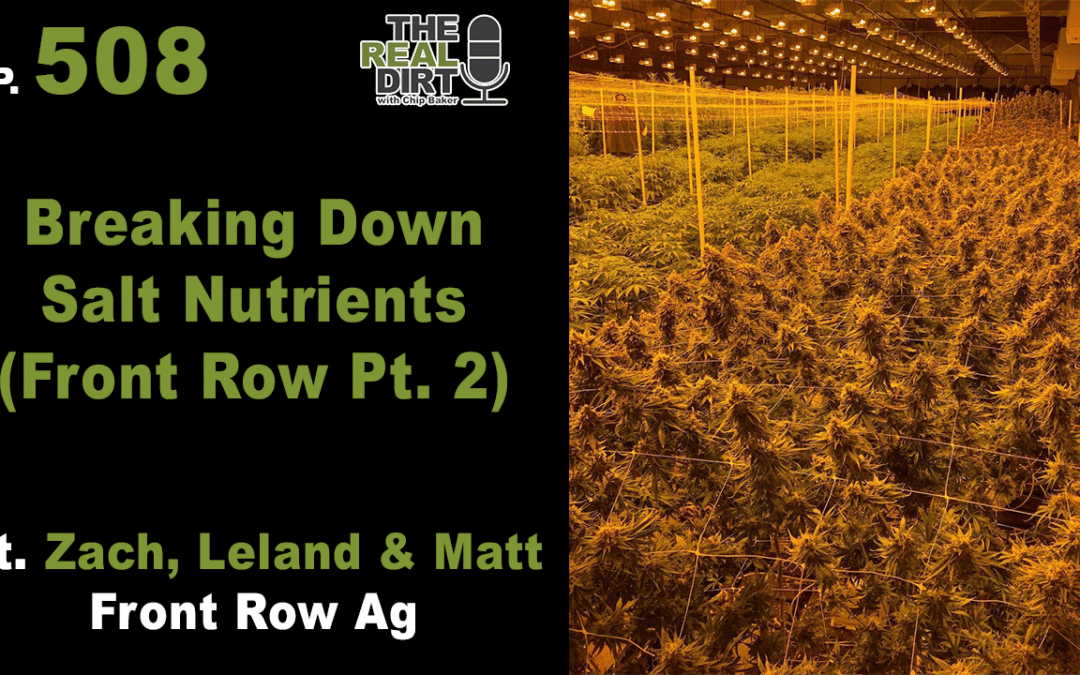
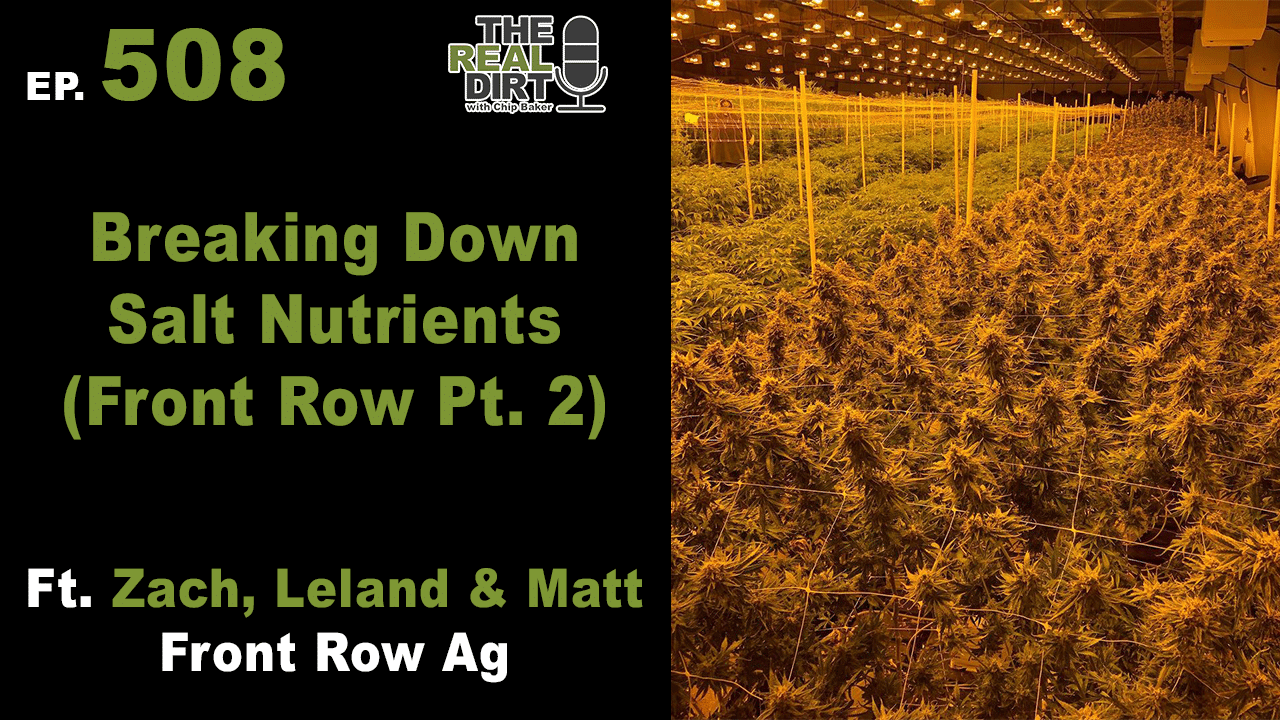
![The Real Dirt on Growing with Salts [Front Row Pt. 1]](https://therealdirt.com/wp-content/uploads/2021/07/Ep507Thumbnail-1080x675.png)
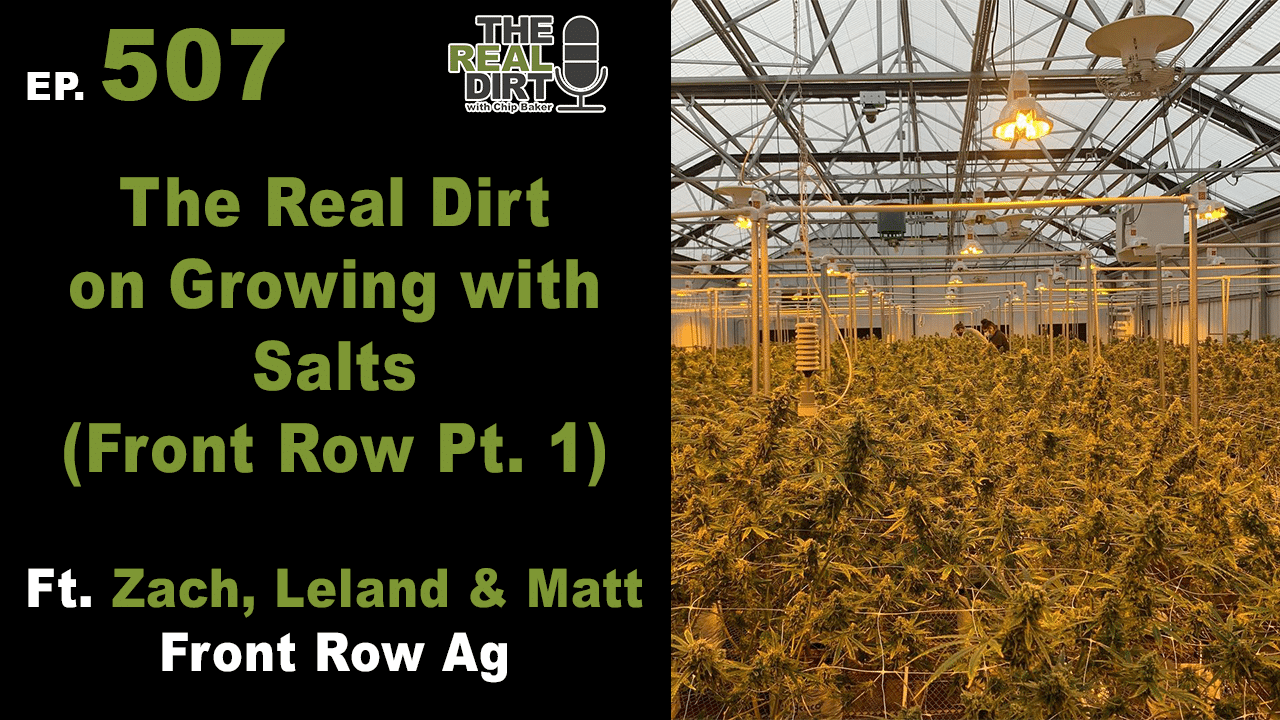
![The Real Dirt on Indoor vs Greenhouse Cannabis [Freaux Pt. 1]](https://therealdirt.com/wp-content/uploads/2021/07/Ep.505YTthumb-1080x675.png)
